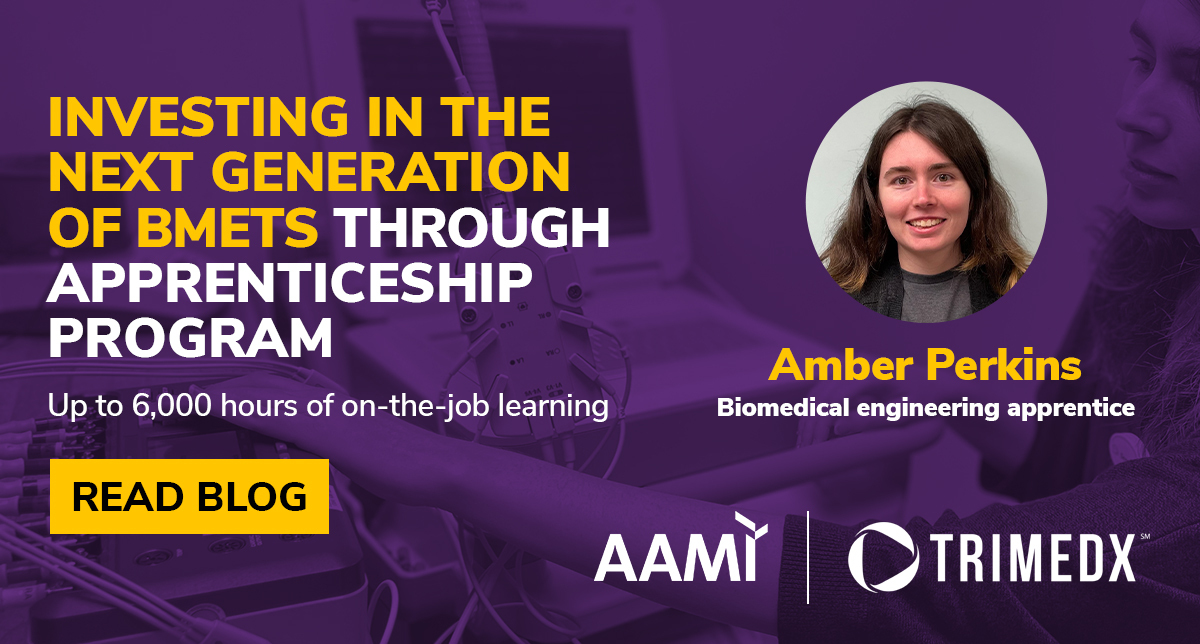TRIMEDX invests in the next generation of clinical engineering talent through a BMET apprenticeship program, in partnership with the Association for the Advancement of Medical Instrumentation (AAMI).
AAMI’s BMET Apprenticeship is recognized by the U.S. Department of Labor and combines traditional education with up to 6,000 hours of on-the-job learning.
TRIMEDX launched the program in 2022 with four BMET apprentices and a class of four additional apprentices started in 2023. The apprentices are based in health systems across the country including North Carolina, Tennessee, Indiana, Montana, Virginia, and Illinois.
The apprentices will work for 24 months with an expert team of TRIMEDX Biomedical Equipment Technicians (BMETs), gaining valuable on-the-job training and experience. Participants also have extensive education requirements including anatomy, medical terminology, physiology, and other related trainings. The cost of these collegiate-level courses is sponsored by TRIMEDX.
Creating a pathway
The BMET Apprenticeship provides a pathway to a career in clinical engineering for people who have little to no experience or non-traditional backgrounds.
“Many may have wanted to join this industry but didn't have a way in. This opened the door,” says TRIMEDX Workforce Strategy Director Courtney Kinkade, “We are willing to pour a significant amount of time and financial investment into training them into their specific BioMed career path of interest.”
Morrey Allen joined the program in 2022, looking for a career change after more than 20 years of workforce experience. He says learning from expert BMETs about new equipment and devices is essential experience he wouldn’t have otherwise.
“Electronics is not in my background. It would be just too abstract if I couldn’t really be here and interact with the guys.”
Amber Perkins, who started as an apprentice in 2023, recently graduated with a degree in computer game design. Looking for more opportunities for growth and stability, Perkins applied for the apprenticeship program. She is now able to use her experience in software to better troubleshoot medical devices and equipment.
“I find it fun and every day there's always something new,” says Perkins. “Every day is not the same.”
Building a talent pipeline
The goal is to create a long-term career trajectory for the apprentices and ensure they are eligible for an advanced BMET position by the time they finish the two-year program.
The first year includes initial training, job shadows, coursework, and learning how to work alongside hospital partners. During much of their second year, the apprentices have the opportunity to explore different specialties including lasers, imaging, or even sterilizers.
“Our ultimate goal is to elevate their career quickly,” says Kinkade.
The U.S. Bureau of Labor Statistics estimates there will be a need for more than 75,000 BMETs by 2032. The BMET Apprenticeship aims to help meet that need, by attracting people to the industry who may not have previously considered it.
Kinkade hopes to transition the apprentices to full-time positions with TRIMEDX once they complete the program. Upon graduation, the apprentices will be well trained and confident propelling them to pursue a long and successful clinical engineering career. Senior TRIMEDX staff working with the apprentices can identify strengths and skills gaps throughout the two-year program and help shape the best career path for them going forward.
Fostering community
To create a culture of belonging, TRIMEDX has worked to build a community around the apprentices. While most of the apprentices are based in different health systems, they have joint classroom forums and consistent surveys and check-ins with leadership.
Some of the first-year apprentices have also been able to mentor and help advise the newest class. That mentorship will prove to be a valuable piece of the program moving forward.
“Learning all these different kinds of machines is fun,” says Perkins, “Then you have the knowledge… and you can pass it on to someone else.”
